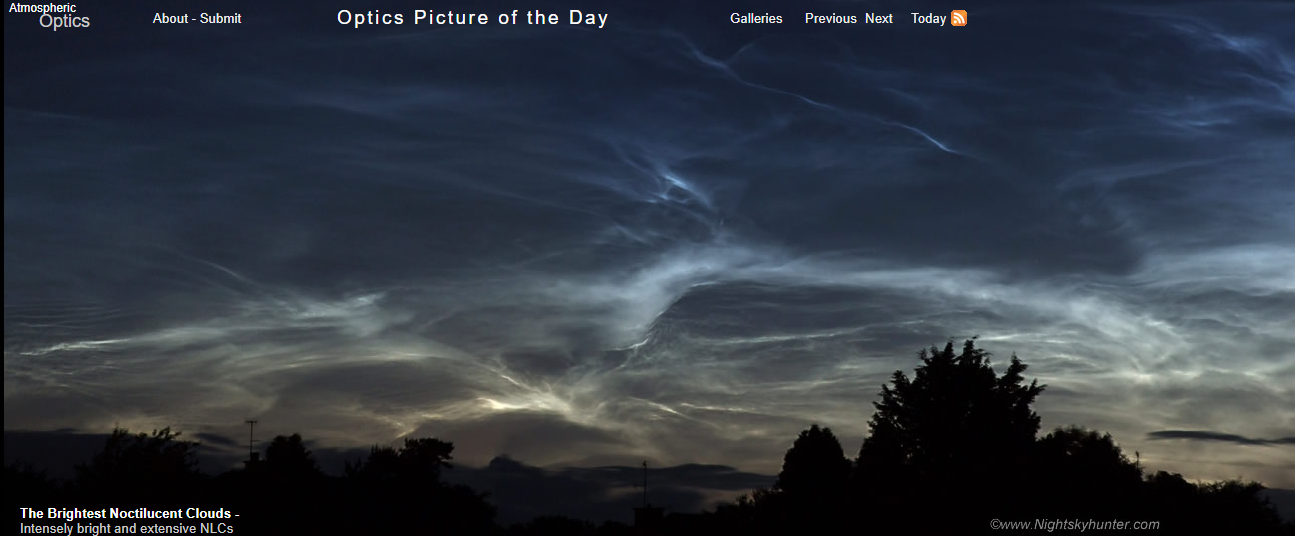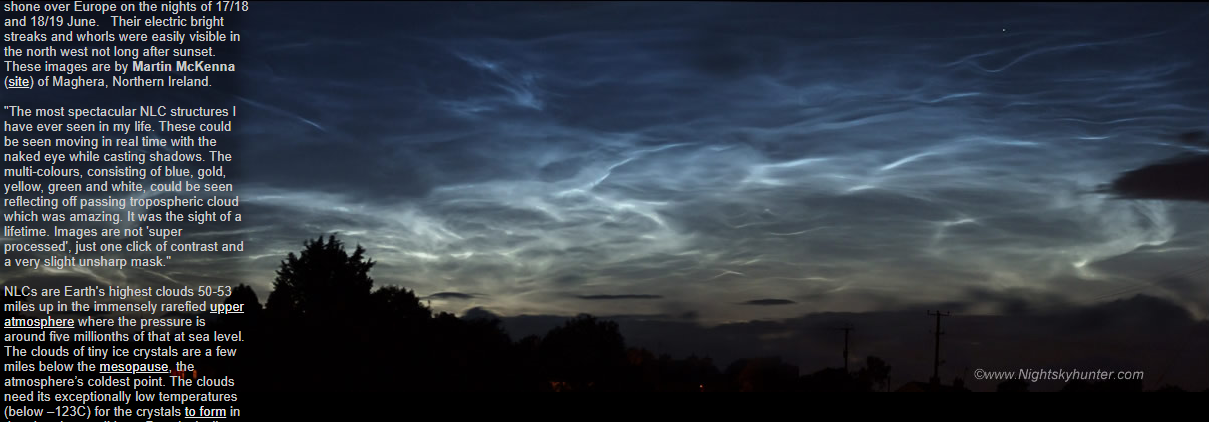Intense NLCs
Intense Noctilucent Clouds: A Spectacular Sight in the Night Sky
Noctilucent clouds (NLCs) are a mesmerizing phenomenon that occurs in Earth's upper atmosphere, approximately 50-53 miles above the surface. These ethereal clouds are composed of tiny ice crystals and are known for their intense brightness and extensive coverage. Recently, on the nights of 17/18 and 18/19 June, Europe was treated to a breathtaking display of intensely bright NLCs. This spectacle captivated observers with its vibrant streaks and whorls, which were visible in the northwestern sky shortly after sunset.
The vivid structures of these NLCs were unlike anything ever seen before. Witnesses marveled at the sight of these clouds moving in real time, casting shadows and creating a stunning interplay of colors. The NLCs exhibited a mesmerizing array of hues, including blue, gold, yellow, green, and white. As an added spectacle, the light from these clouds reflected off passing tropospheric clouds, creating a truly magical visual experience. It was an extraordinary event that left a lasting impression on all who had the privilege of witnessing it.
To fully appreciate the significance of these intense NLCs, it is important to understand their unique characteristics and formation process. Noctilucent clouds exist in the mesosphere, which is the layer of Earth's atmosphere that lies between 50 and 53 miles above sea level. At this altitude, the air pressure is incredibly low, approximately five millionths of that at sea level. It is within this rarefied upper atmosphere that the conditions necessary for NLC formation occur.
The formation of NLCs requires exceptionally low temperatures, typically below –123°C, as well as extremely dry conditions. These conditions are found in the mesopause, which is the coldest point in the atmosphere. Paradoxically, the mesosphere reaches its lowest temperatures during the summer months. The combination of low temperatures and minimal moisture allows for the formation of ice crystals, which make up the NLCs.
The recent display of intense NLCs over Europe serves as a reminder of the beauty and complexity of our atmosphere. These clouds, although located at great heights, have a profound impact on the visual landscape, captivating observers with their luminosity and intricate patterns. As we gaze at these celestial wonders, it is important to appreciate the delicate balance of factors that contribute to their formation.
While the recent event in Europe was particularly remarkable, NLCs are not exclusive to this region. They can be observed in other parts of the world as well, albeit under specific conditions. Scientists and sky enthusiasts continue to study and monitor these clouds, aiming to unravel the mysteries surrounding their formation and behavior.
In conclusion, the intense NLCs that graced the European skies on the nights of 17/18 and 18/19 June were a sight to behold. Their extraordinary brightness and extensive coverage left observers in awe of their beauty. As we marvel at these celestial wonders, we are reminded of the intricate processes that shape our atmosphere and create such captivating displays. Whether they are observed in Europe or elsewhere in the world, Noctilucent clouds continue to captivate our imagination and inspire scientific inquiry into the mysteries of our planet's upper atmosphere.

The Brightest Noctilucent Clouds - Intensely bright and extensive NLCs shone over Europe on the nights of 17/18 and 18/19 June. Their electric bright streaks and whorls were easily visible in the north west not long after sunset. These images are by Martin McKenna (site) of Maghera, Northern Ireland.
"The most spectacular NLC structures I have ever seen in my life. These could be seen moving in real time with the naked eye while casting shadows. The multi-colours, consisting of blue, gold, yellow, green and white, could be seen reflecting off passing tropospheric cloud which was amazing. It was the sight of a lifetime. Images are not 'super processed', just one click of contrast and a very slight unsharp mask."
NLCs are Earth's highest clouds 50-53 miles up in the immensely rarefied upper atmosphere where the pressure is around five millionths of that at sea level. The clouds of tiny ice crystals are a few miles below the mesopause, the atmosphere’s coldest point. The clouds need its exceptionally low temperatures (below –123C) for the crystals to form in the ultra dry conditions. Paradoxically, the mesosphere is at its coldest in summer.

Note: this article has been automatically converted from the old site and may not appear as intended. You can find the original article here.
Reference Atmospheric Optics
If you use any of the definitions, information, or data presented on Atmospheric Optics, please copy the link or reference below to properly credit us as the reference source. Thank you!
-
<a href="https://atoptics.co.uk/blog/intense-nlcs/">Intense NLCs</a>
-
"Intense NLCs". Atmospheric Optics. Accessed on November 25, 2024. https://atoptics.co.uk/blog/intense-nlcs/.
-
"Intense NLCs". Atmospheric Optics, https://atoptics.co.uk/blog/intense-nlcs/. Accessed 25 November, 2024
-
Intense NLCs. Atmospheric Optics. Retrieved from https://atoptics.co.uk/blog/intense-nlcs/.